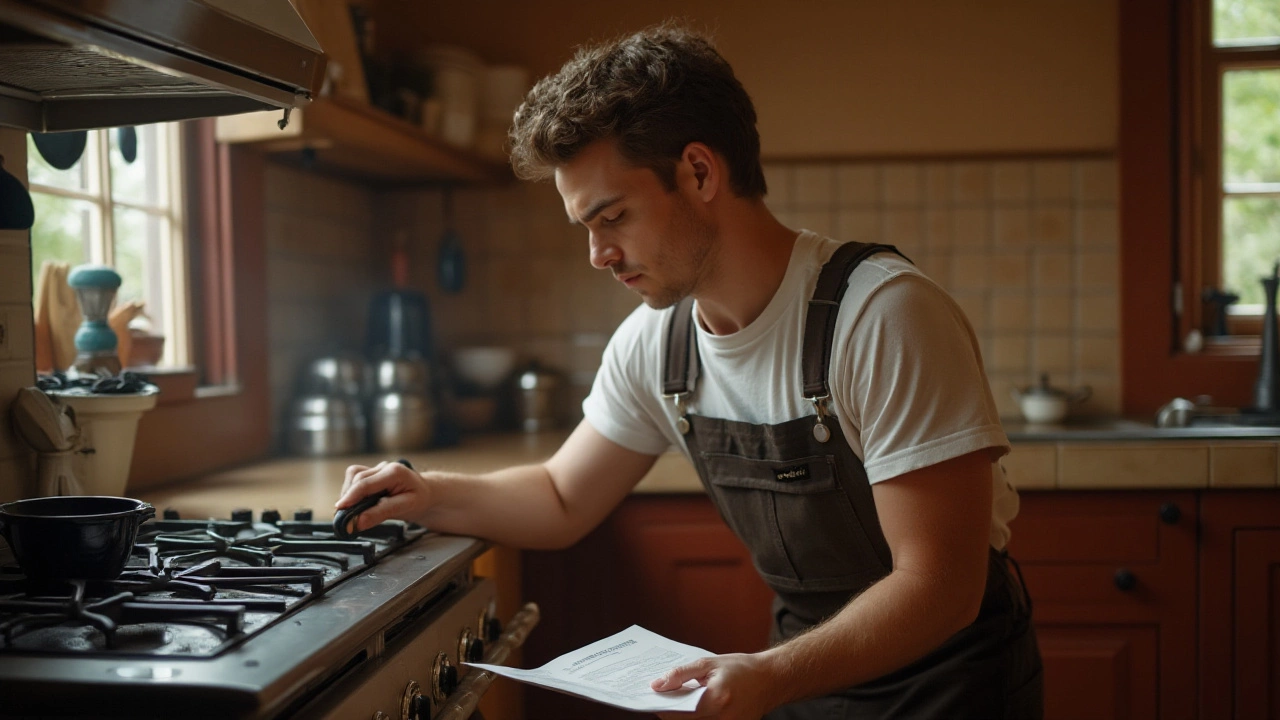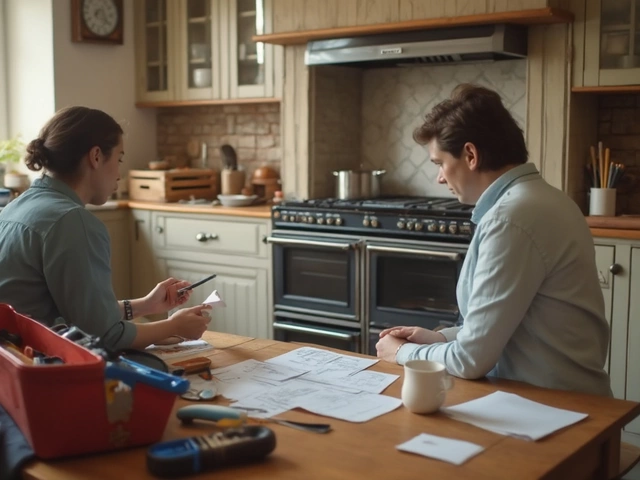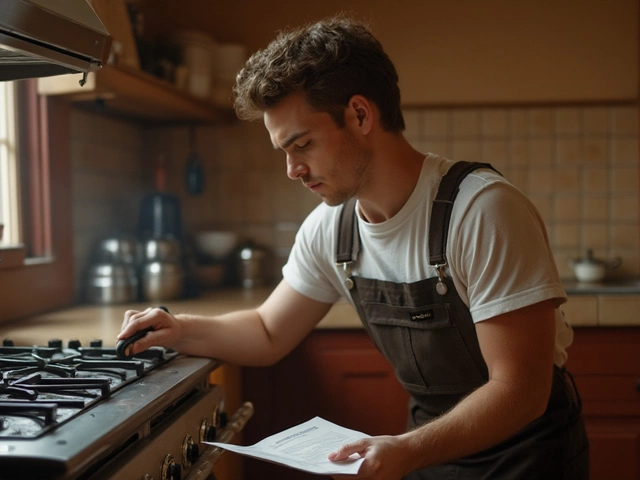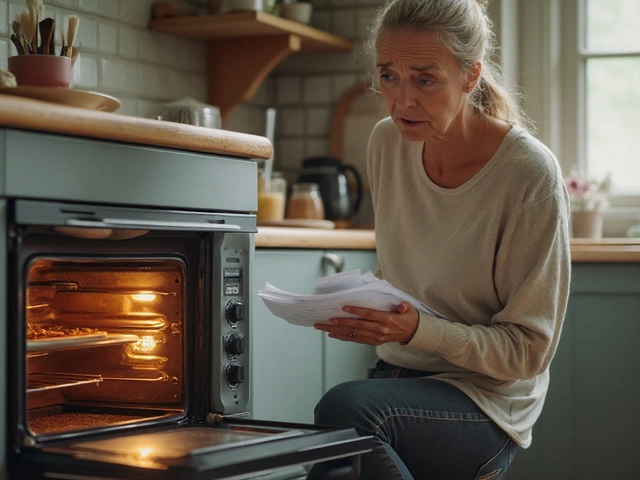If you've ever found yourself frustrated by undercooked meals or an oven that simply won't heat up, you're not alone. Ovens, while robust, can experience a range of issues over time—be it from regular wear and tear or specific component failures. Knowing how to troubleshoot these problems can save you time and potentially expensive repair bills.
In this article, we'll dig deep into the most common problems you might encounter with your oven. From being proactive about maintenance to understanding how each part functions, we'll equip you with the knowledge needed to tackle most of the typical hurdles. Whether you're facing uneven cooking or your oven refuses to heat up at all, understanding what's wrong is the first step in fixing it.
With some patience and the right approach, oven repair doesn't have to be an intimidating task. We will guide you through the process, helping you become more self-sufficient in maintaining one of the most relied-upon appliances in your kitchen. Let's get started and bring back the joy in your cooking!
Understanding Your Oven
Your kitchen is an orchestra of culinary tools, and the oven is its conductor—presenting symphonies of roasts and beautifully baked treats. But to keep this maestro performing in top condition, it's vital to understand the intricate components that make it tick. From the thermostat that regulates its temperature to the elements that provide the heat, each part plays a significant role in your oven's functionality. Knowing how these elements interact can be remarkably beneficial when troubleshooting issues. Indeed, an oven is not just about design; it’s about the harmony between parts that allows you to whip up delicious meals.
Internally, most ovens have two types of heating elements: the bake element at the bottom and the broil element at the top. These elements supply the necessary heat to cook your food evenly. However, should you find that your dishes are cooking unevenly or not cooking at all, these elements are among the first components to inspect. Typically, a malfunctioning element will show visible signs of wear like breaks or blisters.
The thermostat is the brain of your oven, dictating the temperature at which all the orchestration occurs. If the heat isn't consistent, verifying the thermostat might be your first step. In some models, replacing a faulty thermostat can be a straightforward task, requiring just a screwdriver to unlock your oven's potential once more. It's interesting to note that ovens may have a 25°F variability in temperature accuracy due to deviations in calibration, meaning a seeming small issue in the thermostat could significantly impact your dish.
Modern ovens often feature digital displays and control boards—a testament to our technological prowess. While these gadgets add precision to cooking, they can also pose new challenges. Be aware that power surges or prolonged power outages may affect their settings, causing them to malfunction. On this point, "Today's ovens are more complex than ever, making understanding the basics even more crucial," says appliance expert Jude Marshall.
"Knowing the inside of your oven is like being in control of a culinary spaceship. The more you know, the better the outcome,"he asserts.
Additionally, it's good to recognize the role of the oven’s door seal—a superhero in maintaining the oven's temperature. A faulty seal can cause significant heat loss, resulting in prolonged cooking times and energy waste. Ensuring a tight seal is crucial for both efficiency and effectiveness. Checking this is simple and can prevent minor annoyances from evolving into major faults.
In the long run, understanding your oven by regularly checking its primary components doesn't just help diagnose issues when they arise. It also prolongs the life of this cherished appliance, keeping your meals delightful and your cooking stress-free. With these insights, you're well on your way to being not just a better home cook, but a master of your culinary domain.

Common Oven Problems
When it comes to oven troubles, certain issues stand out as particularly frequent among homeowners. One common issue is when an oven doesn't heat to the set temperature. This problem can lead to meals being either undercooked or taking longer to complete than anticipated. A faulty heating element often causes this, where either the bake or broil elements do not glow red. Another possibility could be a broken temperature sensor or a defective thermostat, throwing off the temperature regulation.
A second prevalent problem is when the oven door does not close properly. This can hinder the oven's efficiency, causing heat to escape and energy to be wasted. A misaligned door or a worn-out door seal might be the culprits. It’s worth checking for any obstructions around the hinges and ensuring that the seal is intact. Household appliances like ovens tend to have trivial parts like rubber gaskets causing big headaches when not functioning correctly.
Let's not overlook the annoyance of an oven that turns off mid-cycle. This might stem from a faulty cooling fan or an issue with the thermal fuse. In some instances, the circuit breaker may trip, suggesting an underlying electrical problem. Fixing these problems usually involves checking the fuse and ensuring that the fan is not clogged with grease or debris.
For those experiencing uneven cooking, the problem usually relates to the oven's calibration. It might bake hotter or cooler than the temp you set, leading to unevenly cooked dishes. Running a basic test with an oven thermometer can tell you if your cooking temperatures are consistent with the settings. A recognizable issue such as this presents an opportunity to recalibrate your oven, which often involves adjusting the oven calibration dial or consulting your owner's manual for specific guidelines.
"Consumer Reports found that poor configuration is one of the top reasons for uneven cooking, underscoring the importance of regular oven maintenance and user checks."
If these issues appear complex, they usually come with straightforward solutions. However, it's crucial to approach these problems with the right tools and a cautious mindset. By understanding the common problems and spotting the initial signs of trouble in your oven, you empower yourself to manage and solve them. Remember, most models come with detailed user manuals that offer useful troubleshooting tips, often saving you from the need for a professional repair service.
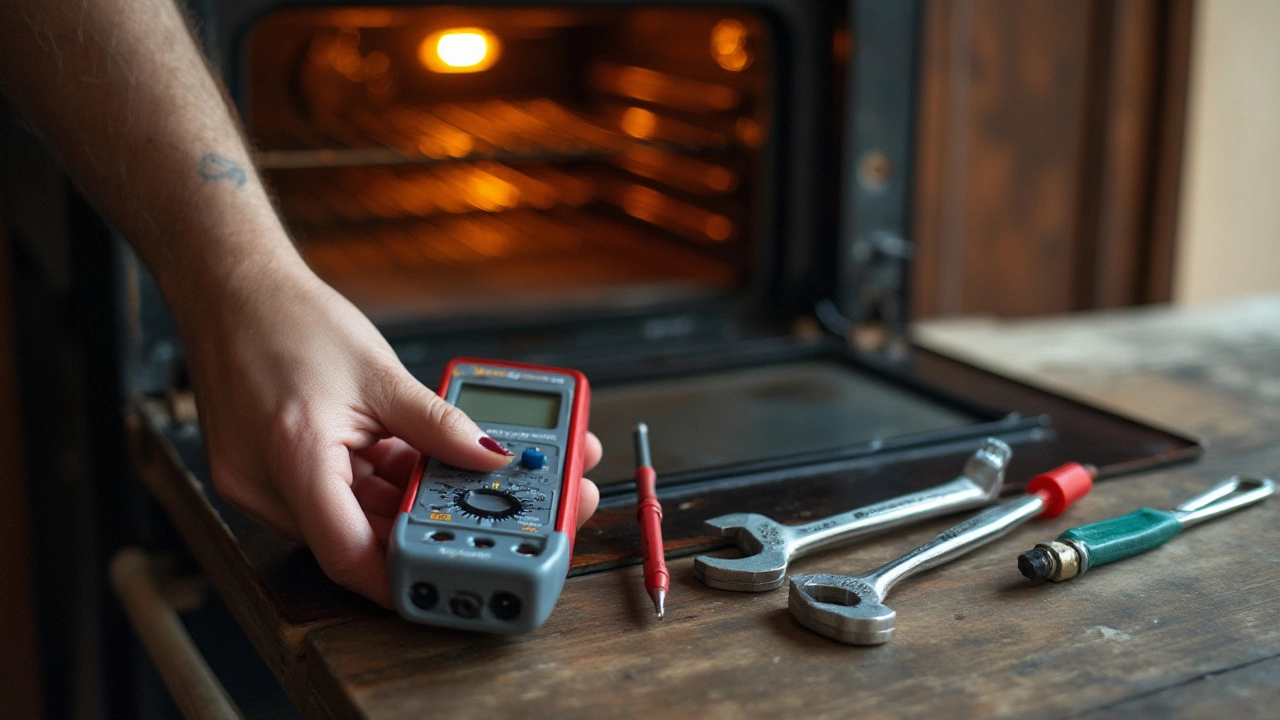
Tools for Troubleshooting
When it comes to tackling issues with your oven, having the right tools at your disposal can greatly simplify the process. With kitchen appliances like ovens, which hide their vital working parts behind solid metal panels, precision tools are key. A basic toolkit for oven repair can boost confidence as you diagnose and remedy common problems. Let's explore what's essential for a successful repair adventure.
First on your list should be a digital multimeter. This handy instrument measures voltage, resistance, and current. It will be indispensable for checking electrical connections or testing a faulty heating element—often the culprit in an oven that won't heat up properly. With a multimeter, you can verify whether electricity is flowing to specific components as it should. Additionally, this tool can help identify a broken thermostat that might be causing erratic temperature control inside your beloved oven. Speaking of which, learning how to use a multimeter might seem daunting, but there's a treasure trove of tutorials and guides online to help you master it in no time.
A set of screwdrivers, both Phillips and flathead, forms the backbone of any good toolkit. From unscrewing back panels to accessing the innards of your appliance, these tools will be your frequent companions. Make sure to have various sizes on hand, as appliances like ovens often use a mix of different screws throughout their construction. In particular, specialized appliance screwdrivers with a longer reach can provide improved access to those hard-to-reach components on the back or at the bottom of your unit. Don't overlook the power of a trusty nut driver set, either, especially when dealing with the ever-present hex head bolts on many oven models.
Also consider insulated gloves. They offer protection from both electrical hazards and residual heat—a must-have when working with high-temperature appliances. Safety goggles, while perhaps not the most fashionable accessory, provide eye protection from accidental wire sparks or errant metal shards when you're prying out tightly fitted parts. Including these safety essentials in your kit ensures you're not putting yourself at risk while addressing issues.
Additional Handy Items
Beyond these foundational tools, having a flashlight—or better yet, a headlamp—will help illuminate the intricate spaces within your oven, especially when needing a closer look at its wiring or those sneaky inner panels. A mirror on a retractable rod can aid you in seeing around corners when you're troubleshooting in those nooks and crannies. Similarly, a telescopic magnet comes in handy for retrieving screws or parts that might slip from your grasp and seem to have vanished into the oven's depth.
Last, but certainly not least, keep a pen and a notepad close. Documenting what you've checked and any noticeable issues can prevent redundant checks, saving your time and energy. Plus, nothing beats having clear notes when it comes to reassembling the various parts you’ve disassembled. As someone once said, '
A short pencil is better than a long memory.'By taking detailed notes, you reduce the likelihood and frequency of repeating earlier steps unnecessarily.
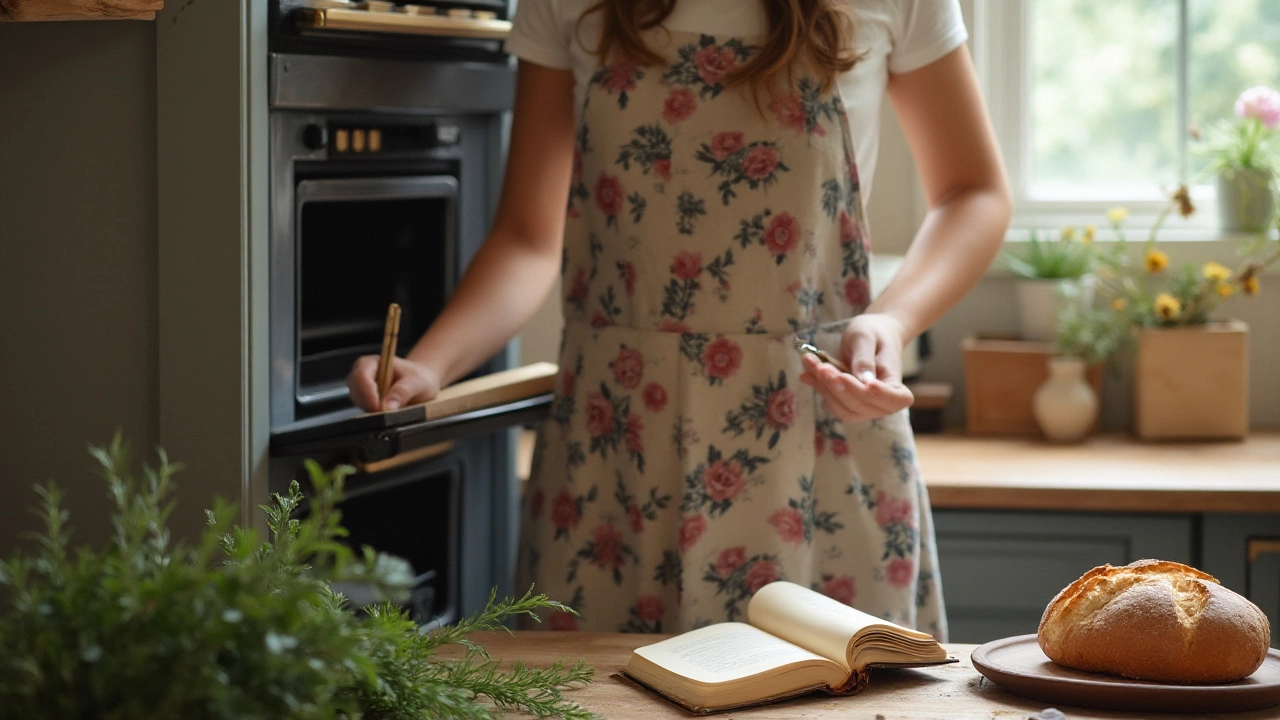
Maintenance Tips
When it comes to keeping your oven in tip-top shape, regular maintenance is key to ensuring its longevity and efficiency. One of the best things you can do is clean up any spills or splatters immediately after they occur. This prevents the build-up of burnt food and grease, which can impede your oven's performance. Use a damp cloth and a mild detergent to wipe the surface clean. Avoid using abrasive scrubbers as they can scratch the oven's interior. If you leave the mess too long, it can be a nightmare to remove, not to mention it might alter the taste of your food.
It's also crucial to periodically check the oven door seals for any signs of wear and tear. These seals play a pivotal role in trapping heat inside. If the seals are damaged or loose, your oven has to work harder, wasting energy and money. Gently close a piece of paper in the door and attempt to pull it out. If it slides out easily then you might need to replace the seal. This small step can significantly improve efficiency, akin to closing your windows in winter to keep your heating bill down.
To keep your oven’s heating elements in great shape, visually inspect them every few months. Look for any signs of damage or irregularities. If you notice they’re not fully lighting up or are showing visible defects, it might be time to replace them. Refer to your oven's manual for specific instructions on testing and replacing these elements. Keeping the heating elements clean from residues with a non-abrasive cleaner can also prolong their life.
Utilizing self-cleaning functions is another maintenance strategy, but it’s not something that should be done frequently. While convenient, the high temperatures can place wear and tear on the components. Limit using this feature to once in a while, when a deep clean is truly necessary. For regular upkeep, a homemade mixture of baking soda and water can do wonders for removing baked-on grime without the downsides of harsh chemical cleaners.
Don't forget to clean behind and underneath your oven, where dust and crumbs can collect over time. This not only keeps your kitchen tidy but also reduces fire hazards. An often-overlooked maintenance tip is calibrating your oven’s thermostat. To test this, place an oven thermometer on the center rack and compare it to the set temperature. If there are discrepancies, consult your manual on how to adjust the calibration, as proper thermostat settings will ensure your dishes are cooked to perfection every time.
According to the Energy Information Administration, kitchen appliances account for about 9% of the total energy used in a home, with ovens being a significant contributor when not maintained properly.
Implementing these maintenance tips for your oven repair approach can extend the life of your appliance, improve its efficiency, and save you from unnecessary repairs. A well-maintained oven is a reliable partner in the kitchen, helping you create culinary delights without the stress of unexpected malfunctions.

